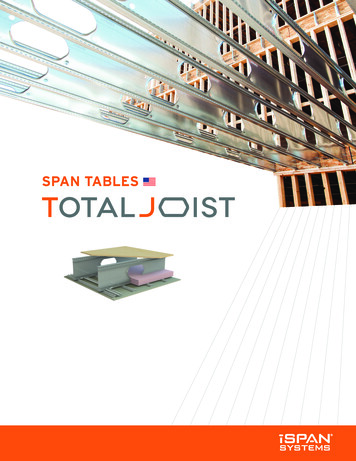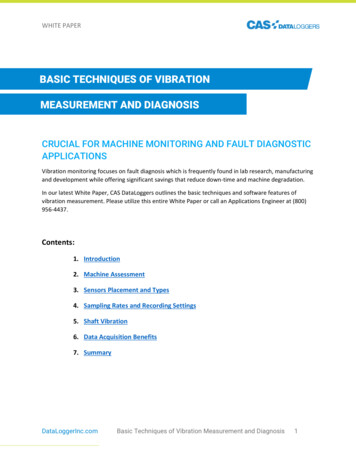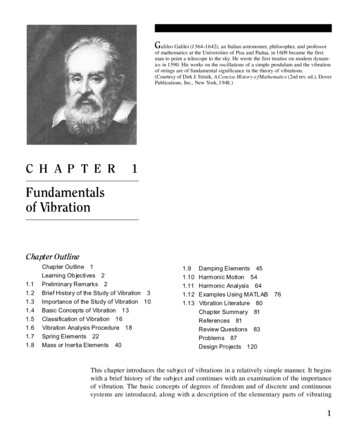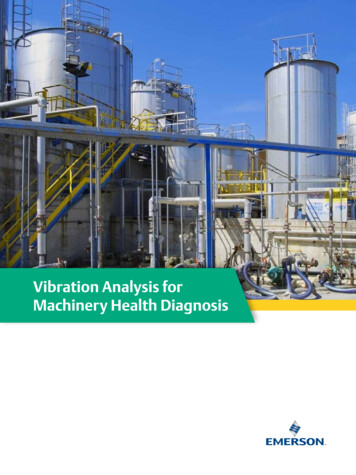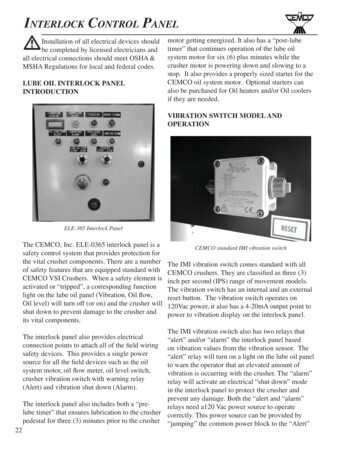
Transcription
Istanbul Bridge ConferenceAugust 11-13, 2014Istanbul, TurkeyDEFLECTION AND VIBRATIONCRITERIA FOR CONCRETE BRIDGESE.-S. Hwang1 and X.H. Le2ABSTRACTDeflection and vibration play an important role on the serviceability of bridges. Some codesspecify deflection or span-depth ratio limit and others specify vibration limit using naturalfrequency or acceleration. Bridge vibration concerns are largely based upon humanperception. Human perception of vibration depends upon a combination of maximumdeflection, maximum acceleration and frequency of response. The paper presents literaturereview of deflection and vibration criteria, as well as human response to vibration in order tounderstanding how these limits affect bridge design and user comfort. Actual bridges thatpresent typical types of concrete bridges are selected for experimental measurement andtheoretical study. The design documents of the bridges are collected for modeling process.The dynamic deflection and acceleration of these bridges are recorded when the test truckcrossing bridges at various speeds as normal traffic. Collected data from field measurementare analyzed in order to determine static deflection and frequency. These values arecompared to analytical predictions. Theoretical and experimental results are then comparedwith design limits as well as other criteria to investigate the applicability of design limit.12Professor, Dept. of Civil Engineering, Kyung Hee University, Yongin, KoreaGraduate Student Researcher, Dept. of Civil Engineering, Kyung Hee University, Yongin, KoreaAuthor IM, Too UR. Template to illustrate paper format for the Istanbul Bridge Conference. Proceedings of theIstanbul Bridge Conference, 2014.
Istanbul Bridge ConferenceAugust 11-13, 2014Istanbul, TurkeyDeflection and vibration criteria for concrete bridgesE.-S. Hwang1 and X.H. Le2ABSTRACTDeflection and vibration play an important role on the serviceability of bridges. Some codesspecify deflection or span-depth ratio limit and others specify vibration limit using naturalfrequency or acceleration. Bridge vibration concerns are largely based upon humanperception. Human perception of vibration depends upon a combination of maximumdeflection, maximum acceleration and frequency of response. The paper presents literaturereview of deflection and vibration criteria, as well as human response to vibration in order tounderstanding how these limits affect bridge design and user comfort. Actual bridges thatpresent typical types of concrete bridges are selected for experimental measurement andtheoretical study. The design documents of the bridges are collected for modeling process.The dynamic deflection and acceleration of these bridges are recorded when the test truckcrossing bridges at various speeds as normal traffic. Collected data from field measurementare analyzed in order to determine static deflection and frequency. These values are comparedto analytical predictions. Theoretical and experimental results are then compared with designlimits as well as other criteria to investigate the applicability of design limit.IntroductionThe goal of the bridge engineer is to design bridges which are durable, serviceable and safe.One of the important concerns in serviceability is the comfort of those crossing the bridges.Although human perceptions are subjected to the vibrations, there is seldom direct provisionin design codes to ensure the user comfort. The current AASHTO LRFD Bridge Design Code[1] specifications specify span-to-depth ratio and static deflection limits in the hope that theselimits will control vibrations. However, the human is primarily sensitive to accelerationsrather than displacement [2].The objective of the paper is to compare and analyze the existing design criteria ondeflection and/or vibration limit in various codes and documents and investigate theapplicability on typical bridge types in Korea through theoretical and experimental study.This study focuses on literature review of deflection and vibration, human response tovibration in order to understanding how these limits ensure the comfort of bridge users.Actual bridges that represent typical types of bridge are selected for experimentalmeasurement and theoretical study. The design documents of the bridges are collected formodeling process. The dynamic deflection and acceleration of these bridges are recordedwhen the test truck or normal traffic cross bridges at various speeds. The collected data fromfield measurements are analyzed in order to determine static deflection and frequency. Thesevalues are compared to analytical predictions. Theoretical and experimental results are thencompared with design limit to investigate the applicability of design limit.12Professor, Dept. of Civil Engineering, Kyung Hee University, Yongin, KoreaGraduate Student Researcher, Dept. of Civil Engineering, Kyung Hee University, Yongin, Korea
Literature review1. History of deflection limitThe current AASHTO LRFD Bridge Design Code specify the bridge deflection limits atL/800 for vehicular bridges and L/1000 for pedestrian bridges as an optional criteria. Inefforts of finding relevant literature, assemble and review from foreign sources, thepreliminary literature indicated that the original deflection limits may be traced back to 1871with the specifications established by the Phoenix Bridge Company (PBC).In 1905, American Railway Engineering Association [3] specification limits thespan-to-depth ratio L/D as the methods control indirectly the maximum live-load deflection.In the early 1930's, the conclusion of the Bureau of Public Roads indicated that theexceeded limit of L/800 will cause unacceptable vibration on structures and the unacceptablevibration is determined by subjective human response. This study specified L/800 as thedeflection limit.In the report of American Society of Civil Engineers [4] on bridge deflection limits,span-to-depth ratio limits and deflection limits for highway bridges are specified as themethod controlling vibration. The report also showed no relationship between structuraldamage and live-load deflection.2. Human response to vibrationIn the field of transportation, the comfort of automobiles, vehicles is a major concern, so theengineers must consider vibrations of bridges. Human reactions to vibrations are bothphysiological and psychological.In 1902, a measurements on human sensitivity to vibration were carried out byMallock [5]. By investigating complaints of unpleasant vibration caused by passing traffic, heconcluded that acceleration is the cause of discomfort. He also found that amplitudes seldomexceeded 0.001 inch and that frequencies ranged from 10 to 15Hz. After that, numerousexperiments in the field of human sensitivity to vibration have been carried out. In 1931,Reiher and Meister [6] produced 6 tolerance ranges based on reactions of 25 adult subjectsbetween the ages of 20 to 37 years. The tolerance ranges are classified as (1) not perceptible,(2) slightly perceptible, (3) distinctly perceptible, (4) strongly perceptible or annoying, (5)unpleasant or disturbing, and (6) very disturbing or injurious is shown in Figure 1After Reiher and Meister, Parmelee and Wiss [7] investigated the effect of dampingupon human sensitivity to vibration and found sensitivity to be proportional to the product ofmaximum displacement and frequency.In 1948, Goldman [8] reviewed the problem and produced from several differentsources, including Reiher and Meister, a set of revised averaged curves corresponding tothree tolerance levels classified as perceptible, unpleasant, and intolerable.In 1984 [9], Janeway's limits recommended that displacement amplitude (a) andfrequency of vibration (f) for various ranges of frequency, as shown in Table 1 and Figure 2.Wright and Walker [10], based on human responses to harmonic vertical vibrationsis shown in Table 2, proposed a vibration related static deflection limit. The limit is acomputed transient peak acceleration of a bridge, α, which should not exceed 100in./s2 (2.54m/s2), where the static deflection, δ, is linked to α as follows:
s 0.05 L ( speed 0.3 f s L) f s(1)where L span length; speed: vehicle speed and fs natural frequency of a simple span bridge.fs 22LEb I bm(2)where EbIb flexural rigidity of a girder section; m: unit mass of a girder section. It should benoted that s needs to be calculated for a live load with a girder distribution factor of 0.7.Table 1. Janeway’s limitsJaneway's limits recommendationaf3 2af2 1/3af 1/60Frequency (Hz)1-66 - 20 20.11af3 20.150.01Displacement Amplitude (inch)Displacement Amplitude (inch)0.16430.001210.0001110Frequency (circles per second)100Figure 1. Human levels by Reiher and MeisterDiscomfortZone0.01af2 1/3ComfortZone0.001af 1/600.0001110Frequency (circles per second)100Figure 2. Vibration limits by Janeway3. Live load deflection criteria3.1. Canadian Standards and Ontario Highway Bridge CodeBoth the Canadian Standard and the Ontario Highway Bridge Code [11] use a relationshipbetween natural frequency and maximum static deflection to evaluate the acceptability of abridge design for the anticipated degree of pedestrian use. The relationship betweenfrequency and deflection in Canadian Standard is shown in Figure 3.This relationship was developed from extensive field data collection and analyticalmodels conducted by Wright and Green. For highway bridges, acceleration limits wereconverted to equivalent static deflection limits to simplify the design process. For pedestrian
traffic, the deflection limit applies at the center of the sidewalk or at the inside face of thebarrier wall or railing for bridges with no sidewalk.Table 2.Peak Acceleration for Human Response to Harmonic Vertical Vibration [10].ImperceptiblePerceptible to SomePerceptible to MostTransient peakacceleration (g)0.0130.0260.052Sustained PeakAcceleration (g)0.0010.0030.005PerceptibleUnpleasant to FewUnpleasant to SomeUnpleasant to MostIntolerable to .259Intolerable to Most5.1780.518Human Response3.2. EurocodesThere is no deflection limit criteria for road bridges. Vibration limits of pedestrian comfortfor footbridge are shown as following:A verification of the comfort criteria should be performed if the fundamentalfrequency of the deck is less than:- 5Hz for vertical vibrations,- 2.5Hz for horizontal (lateral) and torsional vibrations.In this code, there is a specification of deflection limit for railways bridges: themaximum total vertical deflection measured along any track due to rail traffic actions shouldnot exceed L/600, where L is span length.3.3. British StandardsIn British Standards, vibration serviceability requirements of foot and cycle track bridges arespecified. When the fundamental natural frequency of vibration exceeds 5Hz for the unloadedbridge in the vertical direction and 1.5Hz for the loaded bridge in the horizontal direction, thevibration serviceability requirement is deemed to be satisfied.3.4. New ZealandIn New Zealand, the 1994 Transit NZ Bridge Manual limits the maximum vertical velocity to0.055 m/s (2.2 in/s). Older versions of this Bridge Manual also employed limits on L/D anddeflection, but these are no longer used in design.3.5. Australian CodesIn Australian Codes [12], the relationship between first mode flexural frequency (Hz) and
static deflection (mm) is shown in Figure 4.60100050Static deflection (mm)Static deflection (mm)significant pedestrianuselittle pedestrian use1001040unacceptable302010acceptable010510First mode flexural frequency (Hz)Figure 3. First Flexural Frequency versusStatic Deflection in Canadian Code [11].12345678910First mode flexural frequency (Hz)Figure 4. First Flexural Frequency vsStatic Deflection in Australian Code [12]4. Summary:In AASHTO LRFD, the specification of limiting span-to-depth ratio and limiting deflectionto L/ 800 for most design situations and L/1000 for urban areas where L is the span length,have been employed for many years since 1871 and no major change have been made forhighway bridges since 1936. American Society of Civil Engineers (ASCE) committee in1958 reviewed historical of deflection limit and investigated the effect of deflection tostructural damage, they concluded that no relationship between excessive live-load deflectionand structural damage and the limiting of deflection seems to be a method controllingvibration. Bridge vibration concerns are based upon human perception, human perception ofvibration depends on velocity of vehicles, deflection, acceleration, frequency. Therefore, inorder to control human perception, many criteria on deflection, acceleration, velocity,frequency have been issued. Oriard (1972) specified limit of velocity, Wright and Walker(1971) produced many level of acceleration, Reiher and Meister, Janeway developed therelationship between natural frequency and maximum static deflection to evaluate the humanresponse. Those limits are also adopted in Canadian and Australian Codes. Many referencesshow that the relationship between displacement and frequency as criteria for vibrationserviceability.The relationships between deflection and frequency specified by Reiher and Meister,Janeway, Canadian code, Australian Code are plotted on the same chart as shown in Figure 5.
1000Canadian CodeStatic deflection (mm)10010Australian Code1Reiher and Meister0.10.01Janeway0.0010.00011First mode flexural frequency (Hz)Figure 5.10Deflection versus frequency in various codes.Experimental programThe bridges included in this study are given in Table 4. Seven bridges that represent typicalbridge types were selected for the field measurement. Especially, two of those use Ultra HighPerformance Concrete (Bridge No.7).Table 4.Seven Bridges Selected for the Testing Program.No.NameType of constructionSpan length (m)1KeumdangPSC Box Girder382KeumdangPSC Beam303GupoRahmen Bridge134SimiyugPSC Beam305Songjeon-yugPSC Beam306ByeogjeyugPSC Box Girder457Andong 1Simple PSC Beam11The bridges were instrumented with accelerometers and Linear VoltageDisplacement Transducer (LVDT). The LVDT are installed at the mid of span of exteriorgirder where give the maximum deflection in order to record dynamic deflection whenvehicles cross. Accelerometers are also placed at the same longitudinal location of LVDT andnear edge of bridge and, where pedestrians use in order to record acceleration of bridges.The test truck ran to cross the bridges with various speed as normal traffic. Dynamicdeflection and acceleration of bridge due to test truck are collected as shown in Figure 6.
Analysis results1. Experimental analysisCollected data from experimental testing including dynamic deflection and acceleration areused to determine static deflection and natural frequency. Static deflection is determined aslive-load deflection when the test truck running at very slow speed (10kmph).First natural frequency is also determined by using Fast Fourier Transform (FFT)algorithm from acceleration data as illustrated in Figure 7.Figure 6. Dynamic deflection and accelerationcollected from experimental measurementFigure 7. Determination of first naturalfrequency by FFT algorithm2. Comparisons to various comfort criteriaThe Wright and Walker recommendations determine an effective allowable peak accelerationbased on the fundamental natural. The value of this peak acceleration is then comparedagainst tabulated limits shown in Table 1. If the peak acceleration exceeds 100 in./s2 themember is to be redesigned. The comparisons with Wright and Walker Criteria are shown inTable 5.3. Comparison with AASHTO Standard SpecificationsThe selected bridges are modeled on Midas Program for theoretical analysis. Deflection dueto design truck (DB24) is also calculated in order to compare with AASHTO deflection limitL/800. All deflection values are shown in Table 6.4. Comparison with other design codesFirst natural frequency calculated from FFT algorithm and deflection due to design truck(DB24) after being multiplied by respond ratio are used to plot on Reiher and Meistercriteria, Janeway criteria, Ontario Highway Bridge Design Code and Australia Code, thenthey are shown in Figure 8, 9, 10 and 11, respectively.
Figure 9 and 10 show almost selected bridges are failing to meet the limits ofcombination of displacement and frequency on Reiher, Meister and Janeway criteria, whilethey are satisfied if compared to AASHTO and Australian code except bridge No.7 whichuses high strength material.Table 5.Comparisons with Wright and Walker Criteria.Bridge #FrequencyAcceleration(80km/h)Wright and WalkerHzin/s2Human yug3.76.07Perceptible to Some5Songjeon-yug3.77.17Perceptible to Some6Byeogjeyug1.51.10Imperceptible7Andong 110.569.74Unpleasant to FewTable 6.Comparison with deflection d deflection (mm)Bridge#TesttruckDB24DB24 257Andong 1112.923.824.333.3113.75
1Displacement Amplitude (inch)Displacement Amplitude 1ComfortZone0.00010.0001110Frequency (circles per second)1100Figure 8. Human levels by Reiher and MeisterFigure 9. Vibration limits by Janeway60.001000.00significant pedestrianuse50.00Static deflection (mm)little pedestrian use100.00Static deflection (mm)10100Frequency (circles per ble10.000.000.100.005.0010.00First mode flexural frequency (Hz)Figure 10. Static deflection and frequencycomparing to Canadian code1 2 3 4 5 6 7 8 9 10 11 12 13 14First mode flexural frequency (Hz)Figure 11. Static deflection andfrequency comparing to Australian codeConclusionsThis paper presents results from evaluation of the deflection and vibration criteria fromcriteria and design codes. Based on the analysis results, the following conclusions could bemade: Relationship between deflection and frequency are commonly used as method to controldeflection/vibration and human perception. The deflection limits and span-to-depth ratio limits specified in AASHTO code is wellabove the actual design values and give no effect in design. All results from test bridges show that all bridges are very disturbing level by Reiher and
Meister and discomfort zone by Janeway. However, by design code criteria, theysatisfied design limit except test bridge No.7 which are high strength material bridge.The bridges using high strength material may have possibility to give unacceptable level.Special consideration may be required in using high strength material in bridge design.AcknowledgmentsThis work is a part of the research project supported by National Research Foundation ofKorea through No.2012R1A1A2006571 and a grant (13RTRP-B067919-01) from RailroadTechnology Research Program funded by Ministry of Land, Infrastructure and Transport ofKorean government. The authors wish to express their gratitude for the financial support.References1.AASHTO. Load Resistance and Factor Design, Bridge Design Specifications America Association of StateHighway and Transportation Official; Washington, D.C., USA, 2008.2.Gaunt, J. T., & Sutton, D. C. Highway Bridge Vibration Studies (Final Report). West Lafayette, IN: PurdueUniversity, Indiana State Highway Commission, U. S. Department of Transportation, 19813.American Railway Engineering Association. Manual of recommended practice for railway engineering andmaintenance of way, containing the definitions, specifications and principles of practice adopted andrecommended by the American Railway Engineering and Maintenance of Way Association, 1905.4.ASCE Structures Division. Deflection Limitation of Bridges. Progress Report of the Committee onDeflection Limitations of Bridges of the Structural Division. Journal of Structural Division, ASCE, Vol. 84,No. 3, 1958.5.Mallock, H.R.A., Vibrations Produced by the Working of Traffic on the Central London Railway, Board ofTrade Report, Command Papers, n. 951, 1902.6.Reiher, H. & Meister, F. J. The Effect of Vibration on People, Vol. 2, No. II, P381. Translation: Report No.FTS-616-RE, Headquarters Air Material Command, Wright Field, Ohio, 1931.7.Parmalee, R.A. and Wiss, J.F., Human Perception of Transient Vibrations, Journal of the StructuralDivision, ASCE, April 1974.8.Goldman, D.E., A Review of the Subjective Response to Vertical Motion of the Human Body in theFrequency Range 1 to 70 Cycles Per Second, Naval Medical Research Institute, Report No. 1, ProjectMM004001, March 16, 1948.9.Janeway, R. N. Vehicle Vibration Limits to Fit the Passenger. Automotive Industries. 1948.10. Wright, R. N. & Walker, W. H. Criteria for the Deflection of Steel Bridges. Bulletin for the America Ironand Steel Institute, No. 19, 1971.11. Ontario Highway Bridge Design Code, Ontario Ministry of Transportation and Communications, FirstEdition, 1978.12. Australian Bridge Design Code. Section six-code Steel and Composite Construction, Austroads,Haymarket, NSW, Australia, 1996.13. Gindy, M. Development of a Reliability-Based Deflection Limit State for Steel Girder Bridges. Ph.D.Dissertation, Department of Civil Engineering, Rutgers, The State, 2004.14. Nassif, H. H. Live Load Spectra for Girder Bridges. Ph.D. Dissertation, Department of Civil Engineering,University of Michigan, Ann Arbor, Michigan, pp. 259, 1993.15. Nassif, H. H., Liu, M. & Ertekin, O. Model Validation for Bridge- Road-Vehicle Dynamic InteractionSystem. ASCE Journal of bridge engineering, Vol. 8, No. 2, p112-120, 2003.16. Wright, D. T. & Green, R. Highway Bridge Vibration. Part II: Report No. 5 Ontario Test Program. OntarioDepartment of Highways and Queen’s University. Kingston, Ontario, 1964.
Istanbul Bridge Conference August 11-13, 2014 Istanbul, Turkey DEFLECTION AND VIBRATION CRITERIA FOR CONCRETE BRIDGES E.-S. Hwang1 and X.H. Le2 ABSTRACT Deflection and vibration play an important role on the serviceability of bridges. Some codes specify deflection or span-depth ratio limit and others specify vibration limit using natural
